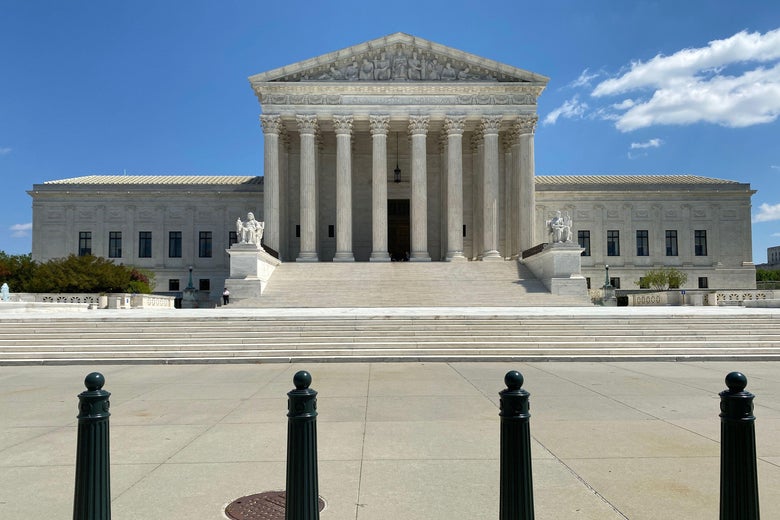
In a deeply fractured opinion, the Supreme Court held on Monday that states must rely on unanimous juries to obtain criminal convictions. (Oregon and Louisiana had previously allowed nonunanimous juries to convict individuals.) The opinion reveals different divisions among the justices, including about when to adhere to the court's prior opinions. But perhaps the most revealing division was about how and when to talk about racial bias in law.
The nonunanimous jury rule at the core of Ramos v. Louisiana has transparently racist origins, which Justice Neil Gorsuch detailed in the majority opinion, joined in most respects by Justices Ruth Bader Ginsburg, Stephen Breyer, Sonia Sotomayor, and Brett Kavanaugh. Louisiana's rule was adopted at an 1898 constitutional convention together with a package of other reforms with the shared purpose of excluding black Americans from the United States political system: a poll tax, a literacy and property ownership test for voting, and a grandfather clause that exempted many white residents from the requirements. One committee chairman explained that the purpose of the convention was to "establish the supremacy of the white race." As Sotomayor wrote separately to underscore, the nonunanimous jury rules have a "sordid history": "the legacy of racism that generated Louisiana's and Oregon's laws." Kavanaugh echoed this claim in his own separate writing: "The convention approved non-unanimous juries as one pillar of a comprehensive and brutal program of racist Jim Crow measures against African-Americans."
This language acknowledging this history outraged the dissenters-Justice Samuel Alito, Chief Justice John Roberts, and Justice Elena Kagan. Alito's dissent claimed that the talk of racism was getting in the way of pure legal reasoning. "Too much public discourse today is sullied by ad hominem rhetoric, that is, attempts to discredit an argument not by proving that it is unsound but by attacking the character or motives of the argument's proponents. The majority regrettably succumbs to this trend." The dissent maintained that "all the talk about the Klan, etc., is entirely out of place" and failed to "set an example of rational and civil discourse instead of contributing to the worst current trends."
For the dissenters, the act of pointing out the rule's unmistakable racist origins-of accusing the state of being racist-was worse than the sordid, racist history itself.
This is not the first appearance of this division between justices who are willing to grapple with race and racist history and those who are not. The justices have been divided on this issue in important voting rights cases as well as in criminal procedure.
Take, for example, Shelby County v. Holder, where a conservative majority of the court invalidated a provision of the Voting Rights Act that required certain states (mostly in the South) with particularly grotesque histories of racial discrimination to pre-clear changes to their voting laws with the federal government. With no discussion of the violent and extraordinary measures that states deployed to prevent black Americans from voting, the conservative majority referred to that past with this sanitized language: "The conditions that originally justified these measures no longer characterize voting in the covered jurisdictions" today. "Nearly 50 years later, things have changed dramatically," Roberts wrote. The dissent, by contrast, engaged with the racist history, and acknowledged it as racist history, to explain why the act should be kept intact. The "blight of racial discrimination in voting," Ginsburg's dissent argued, proved hard to stamp out: "Early attempts to cope with this vile infection resembled battling the Hydra. Whenever one form of voting discrimination was identified and prohibited, others sprang up in its place."
Acknowledging racism and racist history is not just symbolically important. The history is, after all, a part of our past; failing to grapple with it omits important context to legal disputes.
Oftentimes, the history will be legally significant: Under modern constitutional doctrine, a statute with a racially discriminatory purpose will violate the equal protection clause even though the same statute, if enacted for a nondiscriminatory purpose, would be perfectly constitutional. So excavating the history and purpose behind a state law is part of constitutional analysis.
Context and history can also shed light on current disputes: In Shelby County, the history of violent and extensive disenfranchisement of racial minorities helped to explain the significance of modern laws that disproportionately burden racial minorities. It was why, Ginsburg memorably explained, invalidating the pre-clearance regime was "like throwing away your umbrella in a rainstorm because you are not getting wet."
In Ramos, the historical origins of the nonunanimous jury provided important context to the operation of the rule today. For a variety of reasons, juries tend to underrepresent racial minorities. The nonunanimous jury rule effectively deprives minority jury members of a say in the verdict in criminal cases when the criminal justice system produces grave racial disparities.
Often, the division over race falls along ideological lines: The more liberal justices have tended to be more comfortable with acknowledging the reality of racism, while the conservative justices would prefer to abstract a case away from the facts.
But the division in Ramos did not pan out this way: The two newest conservative justices, Gorsuch and Kavanaugh, each wrote opinions explicitly calling the origins of the nonunanimous jury rule racist. And the two conservative justices appointed by the last Republican president wrote or joined an opinion expressing discomfort with their new colleagues' tone and language. (They were even joined by one of their progressive colleagues, Kagan.)
There is no easy way to confront race and racism in the law. But that cannot mean the solution is to avoid talking about race at all. Perhaps Ramos signals that a new majority of the court is occasionally willing to acknowledge portions of America's racist history. Perhaps someday a majority of the court will be willing to do so in voting rights cases and across the board.